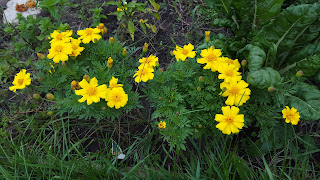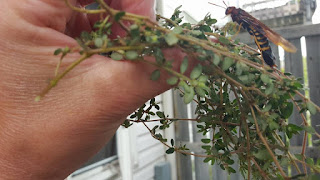13 February 2022
Sunday
Ottawa, Ontario, Canada
I remember many shrubs and fruit bearing trees that I enjoyed as a young kid. Growing up around farm lands, these fruit trees are around me, and they are just available throughout the year when it is in season. Some become my favorite, just grow wild around our old farm, some are fruits that can be easily found in the market when in season.
While it is difficult to be bring them with me, some are imported in Canada at higher cost, so I am compiling the list, so probably I can plant them in my small farm soon, when I get the chance to find a tropical land.
Balimbing - Starfruit - Averrhoa carambola - Wikipedia.
This is a small tree, or a shrub. It grows near Tiya Rata Store, and I use to be the beneficiary of this fruit tree. I will run some errand to the store, then I will basically ask her if the fruit is for sale. She would usually grab a handful and I will come home hapily munching on this fruit.
~~~~~~~~~~~~~~~~~~~~~~~~~~~~~~~~~~~~~~~~~~~~~~~~~~~~~~~~~~~~~~~~~~~
Lansones- bulahan- Lanzones (Lansium domesticum)
This fruit is readily available during a visit to Alegria to Lolo Faran, he is an old man who is "manghihilot". He was an old man like a grandfather that treated you with your broken limbs and try to fix you - granting I feel on so many trees more than I can count. And he has healing oil. He was a popular local alterntive medicine doctor and he was very kind to our family.
I remember the walk to his home clinic, and the path is lined with lansones. Sure enough, after the healing journey, my ma and pa will have a bag of lansones for me.
~~~~~~~~~~~~~~~~~~~~~~~~~~~~~~~~~~~~~~~~~~~~~~~~~~~~~~~~~~~~~~~~
- Lomboy, duhat - Syzygium cumni
- - these grow near our old farm, and during the season, this is a favorite tree to climb. Me and my brother had a funny story how we fall and ride in the branches down probably 20-30 feet in height, and we walk out scratch free. Syzygium cumini - Wikipedia
from wiki: "
Syzygium cumini, commonly known as Malabar plum,[3] Java plum,[3] black plum, jamun or jambolan,[4][5] is an evergreen tropical tree in the flowering plant family Myrtaceae, and favored for its fruit, timber, and ornamental value.[5] It is native to the Indian Subcontinent, adjoining regions of Southeast Asia, including Myanmar, Sri Lanka, and the Andaman Islands.[4][2] It can reach heights of up to 30 metres (98 ft) and can live more than 100 years.[4] A rapidly growing plant, it is considered an invasive species in many world regions.[5] "
~~~~~~~~~~~~~~~~~~~~~~~~~~~~~~~~~~~~~~~~~~~~~~~~~~~~~~~~~~~~~~~~~~~~
Sineguelas - Cireguelas, Jacote Tree - Spondias purpurea
-
Sapondias purpurea - Wikipedia - Another fruit tree that is available seasonally and I climbed the tree to gather them. There used to be a tree at Lolo Eding and Lola Norings farm, I visit them when I can. I have fun memories gathering them, and bringing baskets of them home. It has a peculiar taste and for sure it is a carefree tree. from wiki "
Spondias purpura is a species of flowering plant in the cashew family, Anacardiaceae, that is native to tropical regions of the Americas, from Mexico to Brazil. It is also very common in most of the Caribbean islands. It is commonly known as jocote, which derives from the Nahuatl word xocotl, meaning any kind of sour or acidic fruit. Other common names include red mombin, plum, purple mombin,[2] hog plum, ciriguela, ceriguela, seriguela, siriguela (Brazil) ciruela huesito (Colombia), ciruela, ciruela traqueadora (Panama), ciriguela, cirigüela,[3] cirguela,[4] cirguelo (Ecuador), and siniguelas (Philippines). It is a popular fruit throughout Central America, particularly in El Salvador, Nicaragua , Honduras and in Costa Rica.[5]"
~~~~~~~~~~~~~~~~~~~~~~~~~~~~~~~~~~~~~~~~~~~~~~~~~~~~~~~~~~~~~~~~~~~~~~~
Sambag - sampalok - Tamarindus indica - The tree was a big one near Manang Warlins place. She is a lovely lady that use to sell plants. I think I have bought some of her bouganvilla and santan ( (ixora sp). Every year, the big gigantic tree produces a lot of fruit. We climb the tree, gather some fruits, and give manang warlin her share. She usually make them into tamarind jam - a mixture of peeled tamarind fruit and brown sugar, and package into tamarind candy. I eat my tamarind as it is, and sometimes, I feel like my tongue is cleaned by abrasive, probably a fruit texture.
~~~~~~~~~~~~~~~~~~~~~~~~~~~~~~~~~~~~~~~~~~~~~~~~~~~~~~~~
Macopa
Family • Myrtaceae
Makopa
Syzygium samarangense (Blume) Merr. & L,M.Perry
JAVA APPLE
Hong hua qing tao
Scientific names Common names
Eugenia javanica Lam. Macopa (Tag.)
Eugenia samarangense (Blume) O.Berg.. Makopa (Tag.)
Jambosa javanica (Lam.) K.Schum. & Lauterb.. Java apple (Engl.)
Jambosa samarangense (Blume) DC.. Java rose apple (Engl.)
Myrtus javanica (Lam.) Blume Samarang rose apple
Myrtus samarangense Blume Wax apple (Engl.)
Syzygium samarangense (Blume) Merr. and L.M.Perry Wax jambu (Engl.)
Syzygium aqueum is closely related to S. malacennsis and S. samarangense. They are separate species. There is also a confusing crossover use of "apple" in their common names. (see Gen. info below)
The three Syzygium species are: (1): S. aqueum, Bell fruit; Tambis; (2) S. malacense, Malay apple; Makopang-kalabaw; and (3) S. samarangense, Java apple, Makopa,
Syzygium samarangense (L.) Merr. & L.M.Perry is an accepted name.
Makopa is a childhood fruit i enjoyed. It is crunchy and reminds me with the texture of Barlett pears. It is a red colored fruit and it grows just beside our old house ( 1983) . I think we don't really own the tree, I think Tiya Panyang or Ite Patring owns it. Since, it was a tree just beside our house, I collect fruits that fall to the ground and they never mind me collecting it and eating it.
Tambis is another fruit tree that seems to be growing beside the makopa. The tambis is more crunchy and juicy and also lighter in color. Like any fruits in my childhood, the fruits fall down and it is my daily routine to gather some of them for my breakfast.
There were 2-3 mango trees besides our house. It was fun when birds eat them, and then half a mango fall to the ground. I gather the mango that are half eaten by the birds. I rinse them, and cut the around the areas where the birds eat. I eat the bird left over.























